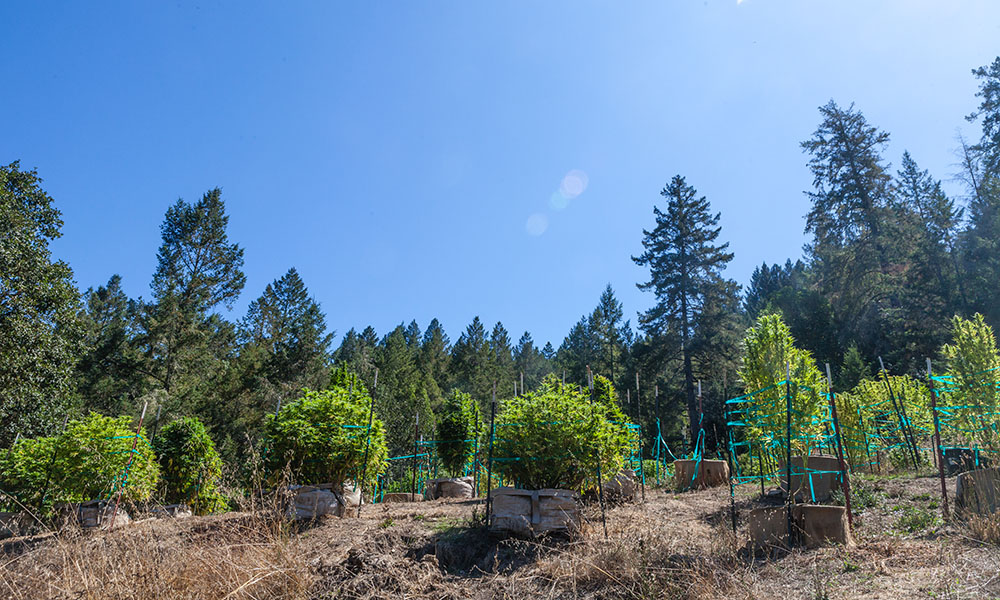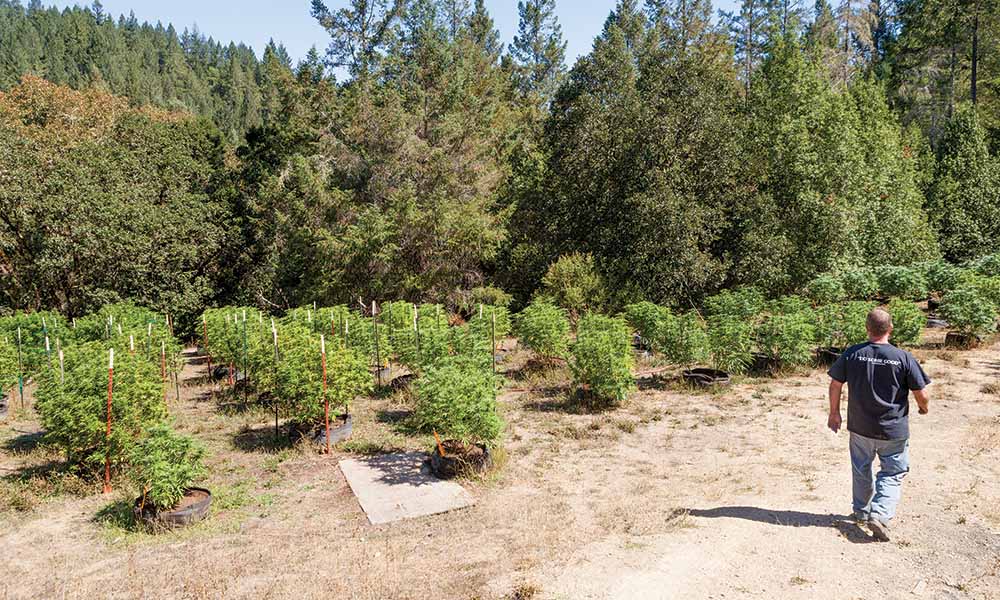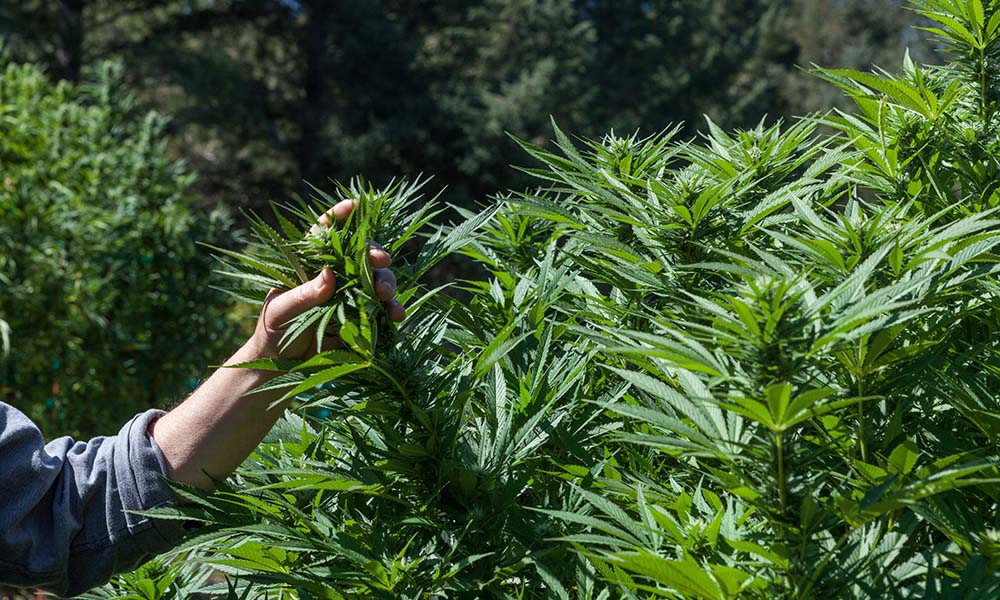Cannabis Country: A Tour of Heritage & Hope
Marijuana tourism comes to California, and brings with it the opportunity to craft the narrative of recreational pot for an outside audience.
To reduce the California cannabis industry into a day, to package it and present it to a novice audience, defies the laws of gravity. Behemoth forces of capital and regulatory government must be reconciled with decades-old cannabis movements resistant to corporate influence, and then filtered through the environmental and political trends affecting every aspect of life nowadays. The task seems insurmountable in a single six-hour tour. But somehow, from the back of a black van at harvest time, I saw a complete picture of the cannabis industry in Sonoma County, California.
Brian Applegarth, the co-owner of Emerald Country Tours, was the man who accomplished the task. Applegarth is a Sonoma local with kind blue eyes and an unpretentious air. On his tour, Applegarth was not of the stand-up comedian tour guide variety, nor the professorial type — he was merely a man who cared, and a man who could provide a window into the full nuances of an industry undergoing a rapid evolution.

On the Emerald Country Tour, I visited the 30,0000-square foot dispensary that calls itself the largest in California. I met experts who talked about Eagle 20 pesticide levels, federal government cannabis patents, and terpene influences in the grow environment. I toured what might be the smallest dispensary in California, tucked into a shoebox house by the banks of the Russian River, where the dispensary workers didn’t want their pictures taken because they’ve had a problem with stalkers. I purchased an eighth of a local farm’s organic Lemon Meringue sativa strain and ate fried chicken and strawberries by the river, with the smell of warm pine needles in the air. I traveled along the highway that would weeks later become consumed in the flames of the Tubbs Fire, one of California’s most destructive fires in history, which experts say was worsened by climate change. What I saw outside the window before the blaze: vineyards, white fences, creeks, redwood trees, twisted oaks.
I put on a blindfold as we drove to a hillside grow, at Applegarth’s suggestion, to mimic the experience of a black-market trimmigrant. I felt a calculated lack of control. I only removed the mask when I heard that sheriff’s department trucks were parked outside the grow — not to shut down the cannabis operation, but to deport an undocumented worker at the neighboring wood mill. (A Sonoma County Sheriff’s Department spokesperson later confirmed it was not a deportation, but an arrest for contempt of court.)
I walked along a gravel road behind the wood mill to the grow, which belonged to a legendary farmer who provides pot to AIDS patients in San Francisco. His name is Oaky Joe. He said, in a buoyant voice projected too loudly across his farm to compensate for an old hearing problem, that he has had more indictments against him dismissed than any other individual in California. He has decoy plants hanging to dry in the trees behind his greenhouse, behind the buckets and bags of regenerative compounds he puts into the soil on his more-than-organic farm. Oaky Joe says he isn’t afraid to invite tourists to his farm because, first, the police already know what he’s doing and have raided him before, and second, because he trusts Applegarth. Oaky Joe introduced us to his children; Oaky Joe’s little dogs introduced themselves to us.

I met two of Oaky Joe’s medical cannabis patients who came to live with on his small farm. Oaky Joe’s grow scientist, Alexander Carpenter, said the two patients were “on their way to a gruesome death.” In the golden afternoon light not yet hindered by smoke, Carpenter showed us their plants, bursting with colas in all directions upward, just weeks away from harvest, growing full and strong.
Throughout the day and at each location, Applegarth told stories. In a clear and tender voice, Applegarth talked about proposed cannabis appellations, the history of 420, the endocannabinoid system, landrace strains, California’s licensing system, and about how he became friends with Oaky Joe as well as what he wants everyone to understand about his home county. I watched a woman run up to Applegarth on the street in Forestville, where we stopped to pick up our lunch. The woman called out to him in a cheerful voice and gifted him a bottle of wine.

Applegarth says he doesn’t care if people smoke cannabis or not on his tours, he just wants people to understand the heritage, the land and the people behind the cannabis industry. “None of this industry would be here if it weren’t for that group of activists in the 20th century — Dr. Tod Mikuriya, Dennis Peron, Brownie Mary, the people who died in the AIDS epidemic,” he says. “I want people to have fun and feel empowered on our tours, but I also want to show people the depth of our culture here.”
I received a gift bag from the first dispensary, and forgot it in the tour van at the end of the day. I did not care; I had gathered more than enough to consider already.

What Kind of Person Takes a Cannabis Tour?
Before Applegarth started his tour company, he visited Colorado and Seattle to conduct research on what the cannabis tourism industry looked like in other recreational markets. He found the people on the tours knew almost nothing about cannabis, making them both impressionable and full of pre-existing notions.
“In the research I did in Colorado and Seattle, I found that the patrons on these tours are brand new,” Applegarth says. “When they see a joint, they think about getting high on a drug, so we think is the most important facet of our tour is re-education. Sometimes I realize that I’m so close to the industry that I want to start talking about something like fractional distillation, but then I remember I need to bring it back to something like male versus female plants, seed versus clone.”
Cannabis tourism’s potential for growth in California is unclear. After Colorado first opened its dispensaries in 2014, the state’s tourism office commissioned a survey of vacationers coming to their state, in an attempt to figure out how many people were “cannabis tourists.” Over 40 percent of tourists surveyed said marijuana was “extremely influential” or “very much influential” in their decision to visit the state. The office’s research found the economic impact of tourism in the state that year surpassed $2.5 billion dollars.

But since the initial bump of interest in 2014, Colorado’s tourism office reported a decrease in people listing cannabis as a significant influence in their travel decisions.
Kirstin Koszorus, the communications manager for the Colorado Tourism Office, said in an email that “traveler interest in legal marijuana appears to have stabilized, with approximately 15 percent of visitors participating in a ‘marijuana-related activity,’ but just 5 percent reporting it as a motivation for their trip.” Koszorus said she has no information about how many cannabis tour companies are operating in Colorado, or the sort of people looking to go on a cannabis tour.
But Applegarth is predicting that there are two major demographics who will be interested in the tours he’s offering: cannabis connoisseurs who care about the bohemian legacies of Sonoma County and the mostly older “canna-curious” crowd who want to be educated on the health benefits of the plant.
Sonoma also already has a unique draw for visitors: its thriving wine tourism industry, which is the engine behind nearly $2 billion dollars of tourism revenue a year, according to the county. But Applegarth believes that the history of federal cannabis prohibition has given cannabis tourism potential in any area with recreational marijuana.
“Alcohol emerged from prohibition in 1933,” Applegarth says. “Cannabis is the wine of today, and there are unavoidable growing pains and important education that needs to ensue for mainstream consumers to understand and embrace cannabis on a wide scale. Tasting rooms will arrive eventually, but for now experiences and events will lead the way.”

Which Stories to Tell?
Currently, Emerald Country Tours faces little competition. Applegarth appears to have been the first cannabis tour guide to officially enter the space in Sonoma County, as he started giving tours in 2017 to medical marijuana cardholders.
Before California’s recreational market opened up in 2018, Applegarth had also founded the California Cannabis Tourism Association and been featured in an NBC Bay Area documentary, in which he is given the title of “cannabis historian.” With this title comes a power of which Applegarth is fully aware: influence over which stories are told about the cannabis industry — and which are not.
“Honestly, with everything about the cannabis industry, whoever is ‘first’ depends on who you ask, on whoever has done the work to position themselves in that narrative,” says Applegarth. “And who you believe always comes back to who you trust.”

By the time the black Emerald Country Tours van dropped us off back at the parking lot outside the local brewery where the tour began, I think I trust Applegarth. At the very least, I am grateful for the narrative that he presents. I’m not sure what other cannabis tours are like. So far, I have only taken the Emerald Country Tour. But on this adventure at least, what I expected (an anxious and impersonal attempt to capitalize on a new market) was far different from what I experienced. I witnessed a vision of the recreational cannabis market where everyone inviting themselves to the party operates their business with at least a modicum of empathy, where past sacrifices are honored and where the future tries to remedy what has been left behind in the rush forward. In short, I saw hope on tour at harvest time.
Originally published in Issue 29 of Cannabis Now. LEARN MORE
TELL US, would you take a cannabis tour?



























